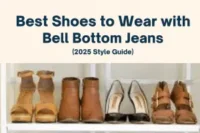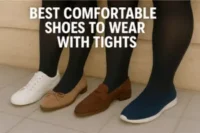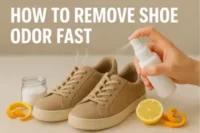How to Stop Shoe Creasing: 10 Proven Tips That Work
Published: 15 Sep 2025
👟 Why Shoe Creasing Happens and Why You Should Care
There’s nothing worse than putting on your favorite pair of shoes and seeing deep creases across the toe box. Whether it’s your go-to sneakers, dress shoes, or limited-edition kicks, creasing can make them look worn out long before they actually are.
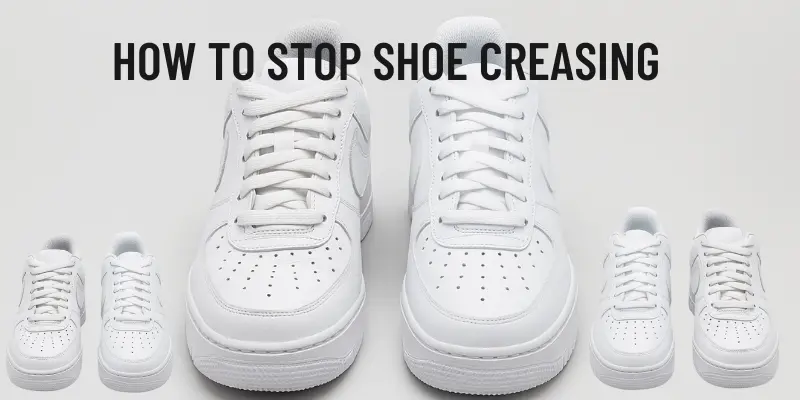
Shoe creases aren’t just a cosmetic issue—they can reduce the lifespan of your footwear and impact resale value, especially for collectors.
The good news? You can stop shoe creasing before it starts. With the right habits, tools, and care techniques, it’s possible to prevent sneaker creases, reduce toe box collapse, and keep your shoes looking fresh from day one.
This guide walks you through how to stop shoe creasing step-by-step—whether you’re commuting, hitting the streets, or rotating your collection. From proper walking technique to crease-resistant materials, you’ll learn how to keep your shoes looking like new—no gimmicks, no stress.
🔍 What Causes Shoe Creases (And Why Some Shoes Are More Prone)
To stop shoe creasing, you first need to understand why it happens. Most creases form where the toe box flexes—right where your foot bends as you walk. Over time, that repetitive pressure causes the material to compress, fold, and eventually crack.
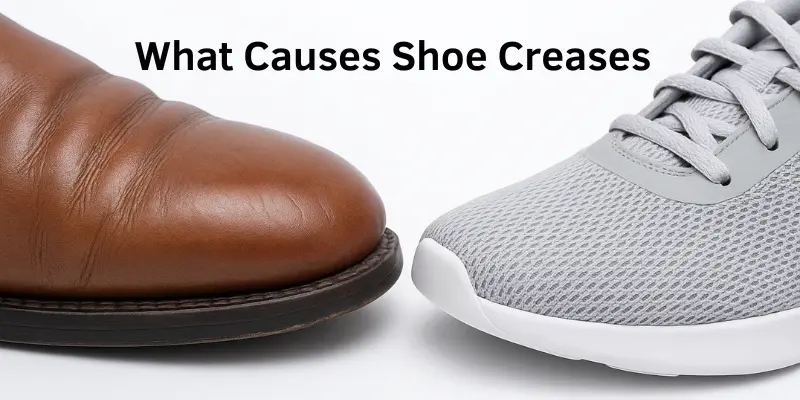
The material of your shoes plays a major role. Leather shoes crease more visibly than sneakers made of knit, canvas, or synthetic mesh. While leather can be conditioned to stay supple, it’s still more prone to permanent folds. Cheap materials also crease faster because they lack structural integrity.
Improper fit is another big factor. Shoes that are too tight or too loose can create unnatural flex points. Add in poor walking posture, moisture exposure, or bad storage habits, and your shoes are creasing before you even notice.
Even though you remove your shoes—like kicking them off—it can lead to premature wear. The more you know about these causes, the better you can fight back.
🛡️ 10 Proven Ways to Prevent Shoe Creasing
Shoe creases aren’t inevitable—you just need the right habits and gear. Here are 10 battle-tested ways to prevent creasing before it starts:
🌲 1. Use Shoe Trees
Insert shoe trees after each wear. They maintain shape, smooth out creases, and absorb moisture—especially if made of cedar wood.
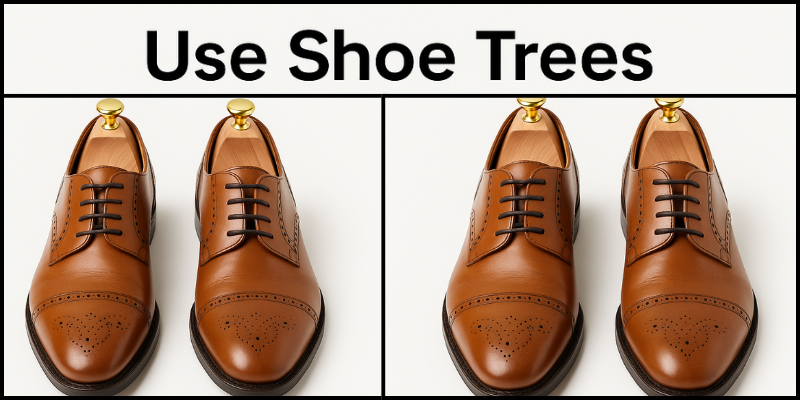
📏 2. Ensure a Proper Fit
Shoes that are too big bend awkwardly; too tight, and they strain at pressure points. A proper fit minimizes flex in all the right places.
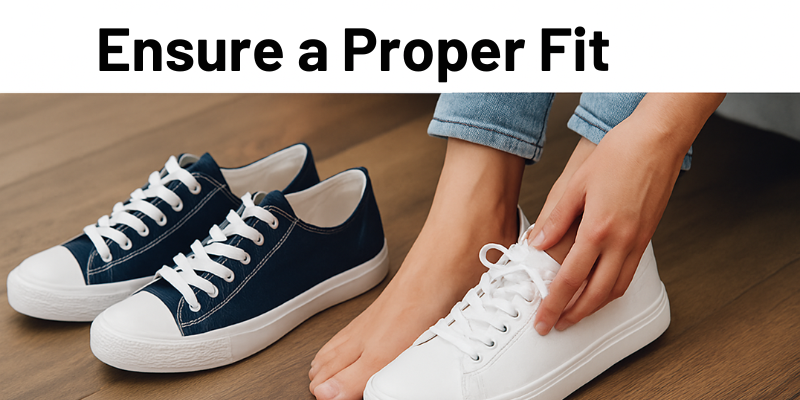
🧽 3. Wear Toe Guards or Inserts
Sneaker shields, foam inserts, or silicone fillers reinforce the toe box, preventing collapse during movement.
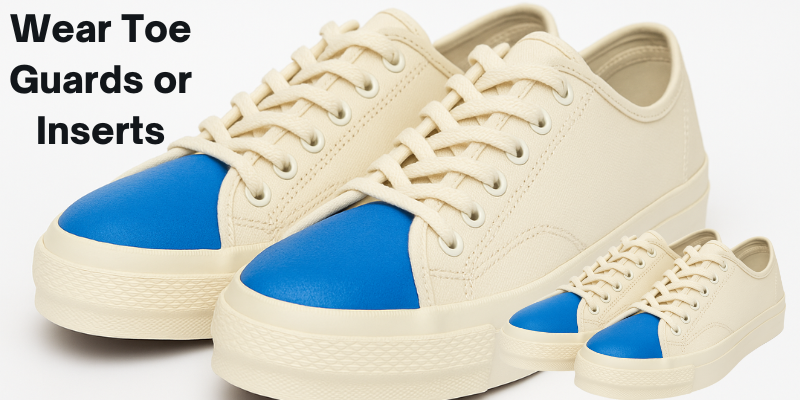
🪢 4. Tighten Laces Properly
Loose laces cause your feet to slide inside the shoe. Keeping them snug helps distribute pressure evenly and reduce bending.
🔁 5. Rotate Your Shoes
Wearing the same pair daily causes faster wear and creasing. Alternate your shoes to give each one time to reset.
🧴 6. Condition Leather Regularly
Apply a premium leather conditioner to maintain flexibility. Hydrated leather bends more naturally and is far less likely to develop deep creases.
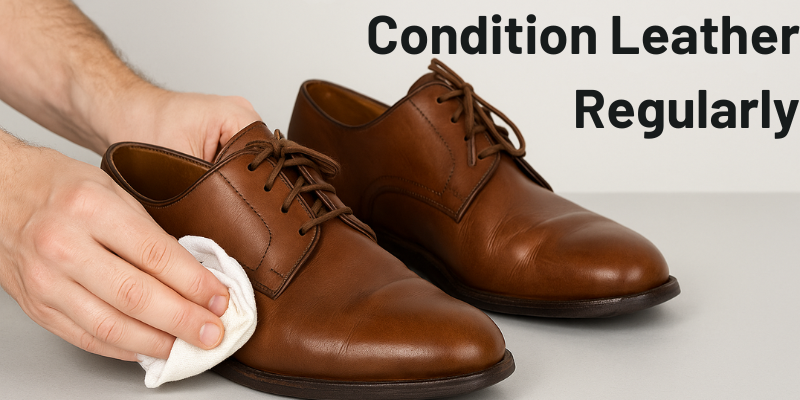
🛡️ 7. Apply Sneaker Guards
These low-profile, hard-shell inserts help prevent creasing, especially in high-end sneakers like Air Force 1s.
🌧️ 8. Avoid Wet Conditions
Water softens leather and can lead to severe creasing. Use a water-resistant spray and avoid puddles or rain.
🚶♂️ 9. Walk Heel-to-Toe
Your gait matters. Walking toe-first creates unnatural flex points. Train yourself to walk heel-to-toe for smoother wear.
📦 10. Store Shoes Properly
Don’t just kick off your shoes. Use shoe trees, dust bags, or open shelves. Store them in a cool, dry place to avoid pressure and humidity damage.
Master these steps, and you’ll stop shoe creasing before it even begins—whether you’re wearing leather boots, sneakers, or dress shoes.
🧍♂️ How Your Walking Style Affects Creasing
Believe it or not, the way you walk has a direct impact on how your shoes crease. Most people never think about this, but your gait pattern—especially how your foot hits the ground—can either protect or damage your shoes.
When you walk toe-first, you apply concentrated pressure to the toe box, causing it to collapse and fold. Over time, that repeated stress leads to deep, permanent creases—especially in leather shoes or tightly laced sneakers.
Instead, train yourself to walk heel-to-toe. Leading with your heel helps distribute weight more evenly across the sole, reducing pressure on high-flex areas. Pair this with good posture (shoulders back, spine neutral), and you’ll not only walk better but extend the life of your shoes.
For those in physically active jobs or on their feet all day, small adjustments in walking style can go a long way. Better movement equals less wear—and fewer creases.
🔧 How to Remove Creases From Shoes (Without Ruining Them)
Even with the best habits, some creasing is unavoidable—especially if your shoes are leather or worn often. The good news? You can remove shoe creases safely with the right methods. Here are the top three ways:
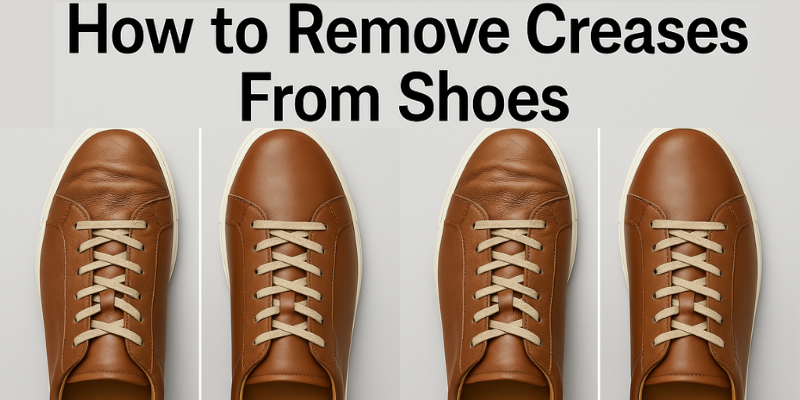
💨 1. Steam Method
Using a clothing steamer or the steam setting on an iron, gently apply heat to the crease area. Place a damp cloth over the shoe and steam it for a few seconds at a time. This softens the material, allowing it to reshape. Always insert a shoe tree or stuff the shoe while it cools to lock in the smooth shape.
🔥 2. Heat + Pressure Method
Use a blow dryer on low heat about 6–8 inches away from the shoe. As the leather warms up, press the crease area using your fingers or a soft cloth. Avoid overheating, and never apply direct heat without a barrier.
🛠️ 3. Professional or Commercial Products
When in doubt, turn to a crease repair kit or professional sneaker cleaning service. They use specialized tools and materials that restore structure without damaging the shoe.
Important: Never rush the process. Too much heat or pressure can warp materials or crack the leather. Always test on a small area first—especially with high-end shoes.
🔁 Smart Shoe Rotation Strategy
Wearing the same shoes every day is one of the fastest ways to guarantee creasing—especially in the toe box. Shoes need time to breathe, rebound, and dry out after wear. That’s why having a smart rotation strategy isn’t just a style tip—it’s essential for preventing sneaker creases and maintaining structure.
Ideally, you should avoid wearing the same pair for two consecutive days. Give each pair 24–48 hours of rest between wears. This helps the material return to its original form, especially when paired with shoe trees during downtime.
If you only own two or three core pairs, you can still rotate effectively. Just plan based on your schedule—commute shoes one day, dress shoes the next, and casual sneakers on lighter use days.
🧠 Pro Tip: Build a simple weekly calendar or checklist. Not only will it save your shoes from creasing, but it’ll also diversify your style effortlessly.
🛍️ Best Products to Prevent Creasing
You don’t need a closet full of sneakers to protect your shoes—you just need the right tools. These crease-prevention products are game-changers for anyone who wants to stop shoe creasing before it starts.
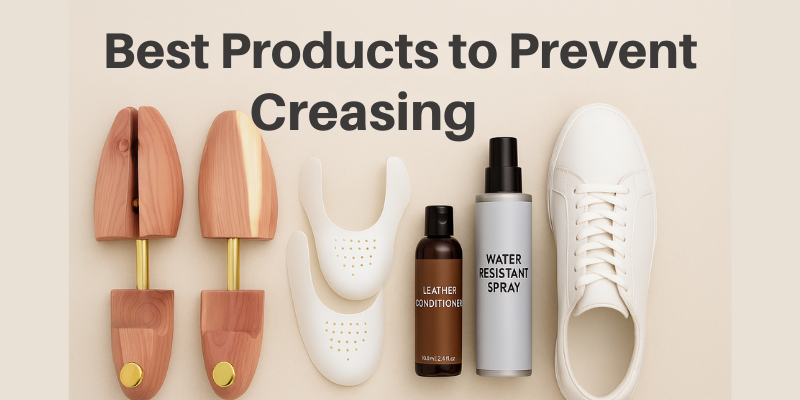
🌲 Shoe Trees
A must-have. They maintain shape, absorb moisture, and smooth out minor creases. Go for cedar shoe trees if possible—they also fight odor.
🛡️ Sneaker Shields / Toe Box Inserts
These are low-profile inserts that sit inside the toe box and prevent collapse as you walk. Look for foam or silicone versions for daily comfort.
🧴 Leather Conditioner
For leather shoes, keeping the material soft and supple helps prevent creasing. Apply conditioner regularly to avoid dry, crack-prone surfaces.
🌧️ Water-Resistant Spray
Moisture weakens fabric and leather, making them more likely to bend and crease. A light spray adds a protective barrier—especially useful in rainy or humid climates.
🧦 DIY Alternatives
In a pinch, rolled-up socks or balled tissue paper can fill out your shoes during storage. Not as effective as professional products, but still better than nothing.
Investing in even one or two of these tools can drastically reduce creasing—especially when combined with proper storage and wearing habits.
🏠 Storage Mistakes That Cause Creasing
Even if you’re doing everything right during wear, poor storage habits can undo your efforts. How you store your shoes directly affects their shape—and long-term creasing.
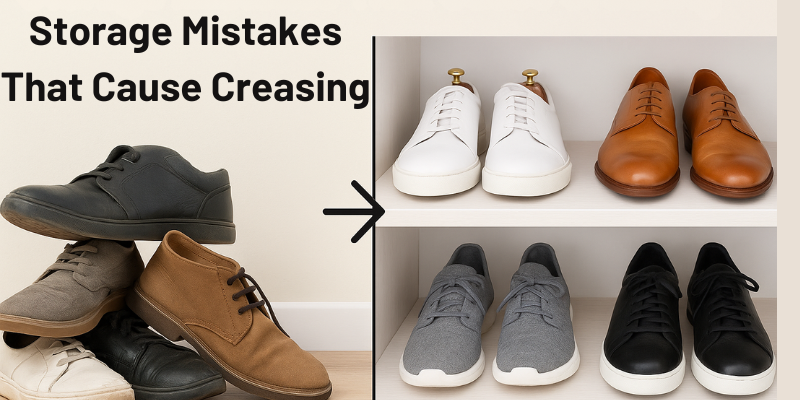
📦 1. Stacking Shoes
Throwing shoes into a pile or stacking them in tight shelves applies uneven pressure. This bends the toe box and causes long-term shoe creasing. Use dedicated shelves or shoe racks with space between pairs.
🌬️ 2. Lack of Ventilation
Shoes need to breathe after wear. Storing them in sealed boxes traps moisture, which softens materials and increases the chance of deep folds. Use breathable dust bags or open shelving when possible.
🪵 3. No Support During Storage
Leaving shoes empty allows them to collapse. Insert shoe trees or at least stuff them with socks or paper to maintain their shape—especially in leather shoes or sneakers with a soft upper.
☀️ 4. Heat and Humidity Exposure
Avoid leaving shoes near windows, heaters, or in your car. Heat and moisture weaken the shoe structure and warp the material, making creases more likely.
A simple change in your storage setup—like spacing out pairs and adding basic inserts—can make a big difference in how long your shoes stay crease-free and fresh-looking.
🧘 When to Accept the Crease
Let’s be real: some creasing is inevitable. No matter how careful you are, shoes are meant to be worn—and worn shoes move, flex, and age. Especially with leather dress shoes or natural materials, minor creasing is part of the story your footwear tells.
In fact, a well-worn crease can even be a mark of character, not a flaw. Just like patina on aged leather, creases can show that your shoes are trusted, lived-in, and styled with purpose.
That said, there’s a big difference between natural wear and avoidable damage. The goal isn’t to eliminate creasing completely—it’s to reduce unnecessary stress, prolong your shoes’ lifespan, and keep them looking sharp as long as possible.
So yes, prevent creasing with smart habits and tools—but don’t let a wrinkle or two ruin the joy of wearing shoes you love.
✨ Conclusion: Keep Your Shoes Looking Fresh, One Step at a Time
Shoe creasing might be common, but it’s far from unavoidable. With a mix of smart habits, the right gear, and a little consistency, you can dramatically reduce toe box collapse, extend the life of your favorite pairs, and keep them looking sharp every time you step out.
From using shoe trees and crease protectors to adjusting how you walk and store your shoes, each step adds up. Whether you’re rocking leather dress shoes, high-end sneakers, or everyday trainers, prevention is easier—and cheaper—than repair.
Remember, a few natural creases are part of the journey. But deep, unnecessary ones? Those are optional. Now that you know how to stop shoe creasing the right way, your kicks won’t just last longer—they’ll stay looking fresh, season after season.
👟 Ready to put this into action? Start with one habit today—your shoes will thank you tomorrow.
❓ FAQs People Ask
Yes—crease protectors (aka sneaker shields or toe box inserts) are one of the most effective tools for preventing sneaker creases. They sit inside your shoe and hold the shape of the toe box as you walk. Just make sure they fit properly so they don’t feel uncomfortable.
Leather shoes, especially full-grain and dress styles, tend to crease the most because the material is stiff and shows folds easily. Cheap synthetic materials crease quickly, too. Knit or mesh sneakers are more forgiving but can still show signs of wear over time.
It can be—if done carefully. Always place a damp cloth between the iron and the shoe, use low heat, and stuff the shoe with a shoe tree or paper to hold its shape. Too much heat can warp the material or cause permanent damage.
First, avoid wearing premium shoes in wet conditions. If they do get wet, dry them at room temperature with a shoe tree inserted—never near direct heat. Use water-repellent spray regularly to add a protective barrier.
Absolutely. Walking toe-first applies direct pressure to the front of your shoes, which speeds up creasing. Heel-to-toe walking spreads pressure more evenly and is one of the easiest, most overlooked ways to extend the life of your shoes.

- Be Respectful
- Stay Relevant
- Stay Positive
- True Feedback
- Encourage Discussion
- Avoid Spamming
- No Fake News
- Don't Copy-Paste
- No Personal Attacks



- Be Respectful
- Stay Relevant
- Stay Positive
- True Feedback
- Encourage Discussion
- Avoid Spamming
- No Fake News
- Don't Copy-Paste
- No Personal Attacks


